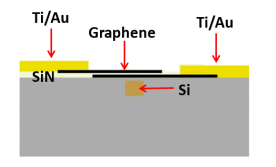
Surface Plasmon and Waveguide Enhanced Graphene Modulation for On-chip Biosensing in Mid-Infrared Region
Synopsis
Silicon-based CMOS integrated with optical systems enables lab-on-chip devices for remote biochemical analysis. Graphene-based modulators, with seamless Si-based CMOS integration and surface plasmonic enhancement, outperform micro-ring resonators in on-chip biochemical sensing. The modulator, featuring two graphene layers, covers a mid-infrared (IR) wavelength range, catering to on-chip biology and biochemical sample analysis.
Opportunity
Optical light, especially from near-IR to mid-IR spectra, has been instrumental for biochemical analysis and biosensing. Silicon-based CMOS integration for data collection, analysis and on-chip communication has led to the development of various products, such as lab-on-chip devices for remote biological and chemical sample analysis. The use and integration of graphene materials offers dual advantages:
- Graphene, unlike metals, is compatible with silicon-based CMOS at the front-end processing layers, enabling seamless process integration and cost-effectiveness.
- Graphene, being a 2D material, enables plasmonic signal enhancement, which can also support broadband modulation.
This graphene waveguide-based modulator structure has a major advantage over micro-ring resonator structures for on-chip biochemical sensing.
Technology
- The modulator comprises a waveguide having with a silicon core and silicon dioxide cladding.
- Additionally, the modulator includes a first graphene layer, acting as absorption layer, arranged on the waveguide, and a second graphene layer, acting as gating layer, arranged above the first graphene layer.
- This configuration enables modulation across a wavelength range that encompasses frequency regimes in the mid-IR spectrum.

Figure 1: Waveguide-enhanced graphene modulation for on-chip biosensing.
Applications & Advantages
- Primary application areas: on-chip biology and biochemical sample analysis.
- Provides absorption with broadband covering near- to mid-IR range.




.tmb-listing.jpg?Culture=en&sfvrsn=3b74ec1c_1)


.tmb-listing.jpg?Culture=en&sfvrsn=414f0d90_1)







